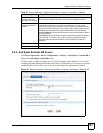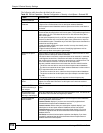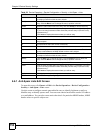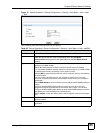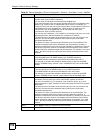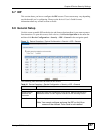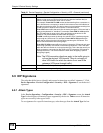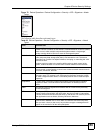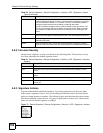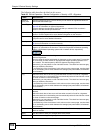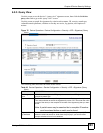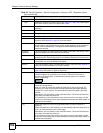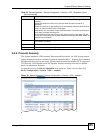
Chapter 6 Device Security Settings
Vantage CNM User’s Guide
159
Figure 72 Device Operation > Device Configuration > Security > IDP > Signature > Attack
Types
The following table describes each attack type.
Table 62 Device Operation > Device Configuration > Security > IDP > Signature > Attack
Types
TYPE DESCRIPTION
DDoS The goal of Denial of Service (DoS) attacks is not to steal information, but to
disable a device or network on the Internet. A distributed denial-of-service (DDoS)
attack is one in which multiple compromised systems attack a single target,
thereby causing denial of service for users of the targeted system.
BufferOverflow A buffer overflow occurs when a program or process tries to store more data in a
buffer (temporary data storage area) than it was intended to hold. The excess
information can overflow into adjacent buffers, corrupting or overwriting the valid
data held in them.
Intruders could run codes in the overflow buffer region to obtain control of the
system, install a backdoor or use the victim to launch attacks on other devices.
AccessControl Access control refers to procedures and controls that limit or detect access.
Access control is used typically to control user access to network resources such
as servers, directories, and files.
Scan Scan refers to all port, IP or vulnerability scans. Hackers scan ports to find targets.
They may use a TCP connect() call, SYN scanning (half-open scanning), Nmap
etc. After a target has been found, a vulnerability scanner can be used to exploit
exposures.
TrojanHorse A Trojan horse is a harmful program that’s hidden inside apparently harmless
programs or data. It could be used to steal information or remotely control a
device.
Other This category refers to signatures for attacks that do not fall into the previously
mentioned categories.
P2P Peer-to-peer (P2P) is where computing devices link directly to each other and can
directly initiate communication with each other; they do not need an intermediary.
A device can be both the client and the server. In the device, P2P refers to peer-to-
peer applications such as eMule, eDonkey, BitTorrent, iMesh etc.
IM IM (Instant Messaging) refers to chat applications. Chat is real-time
communication between two or more users via networks-connected computers.
After you enter a chat (or chat room), any member can type a message that will
appear on the monitors of all the other participants.



